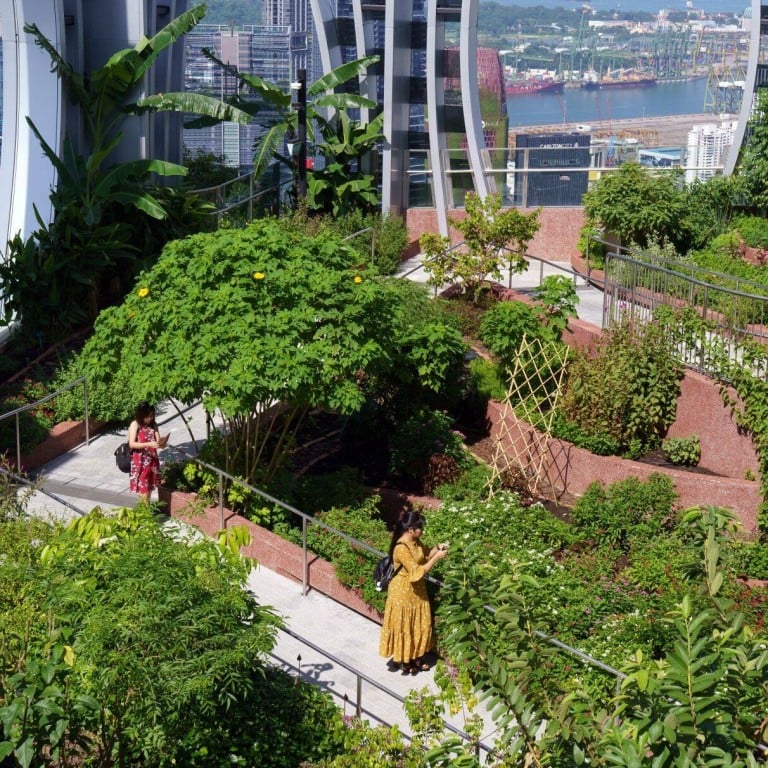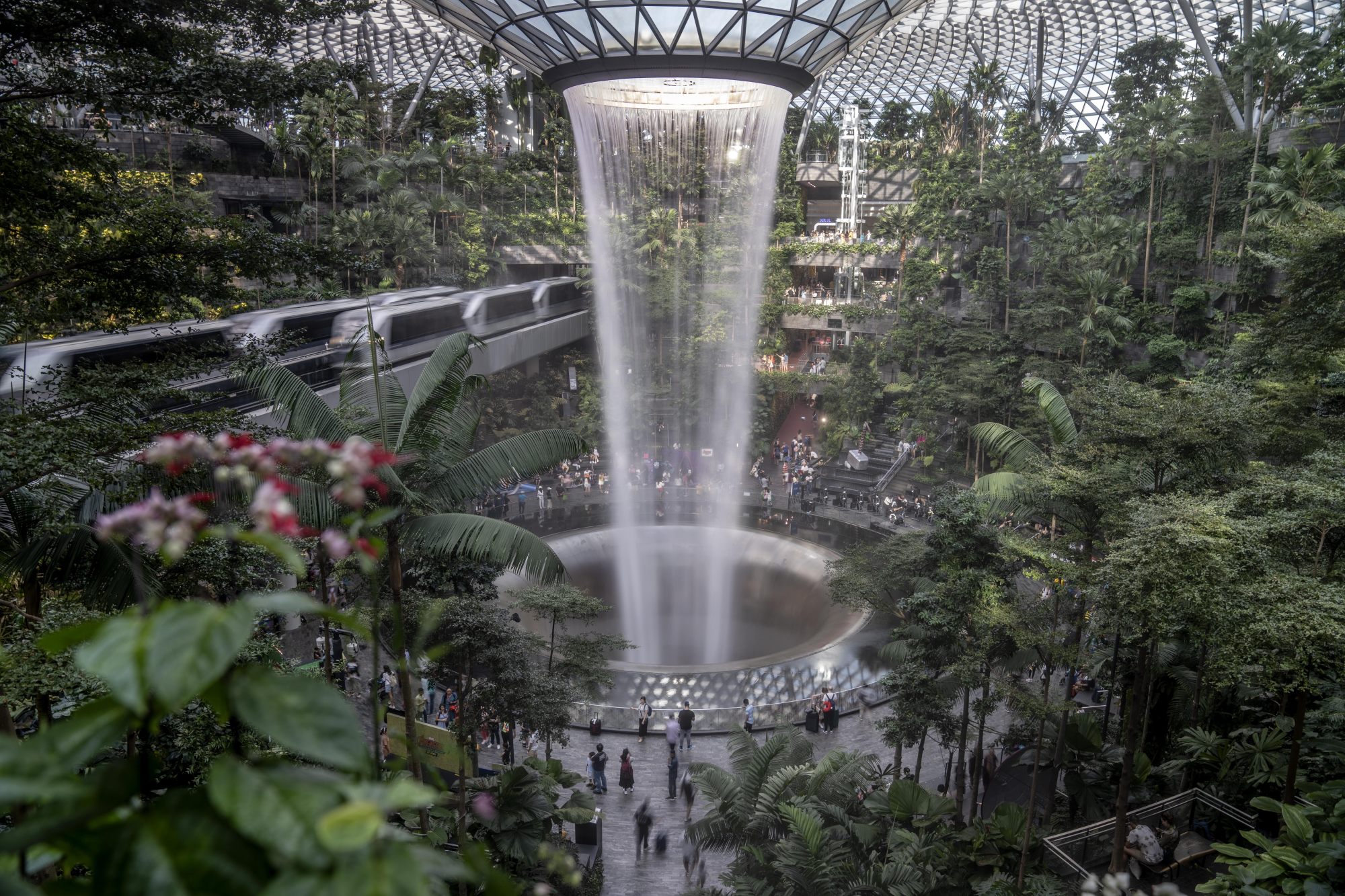
Singapore plants the seeds for a green revolution to turn city state into a garden
- Singapore’s government has a goal to plant 1 million new trees by 2030, so in the future no citizen should live more than a 10-minute walk from a park
- Hundreds of kilometres of routes will connect the various green spaces directly with each other under the city state’s ‘Green Plan 2030’
Whether it’s the vertical jungles on the fronts of buildings or the 18 futuristic Supertrees with more than 160,000 plants growing on their metal scaffolding. As an ecological innovator, Singapore is taking it to the next level.
Some say that Singaporeans live in restricted spaces, almost everybody in apartments without having their own garden. To them I say: ‘Guys, the whole city is my garden!’
“Some say that Singaporeans live in restricted spaces, almost everybody in apartments without having their own garden,” said Gee Soo, who works as a city guide for Hello! Singapore Tours.
“To them I say: ‘Guys, the whole city is my garden!’ No matter which window you look out of, you always see greenery.”
Kerstin Vieth, a German who moved to Singapore 11 years ago, also appreciates the advantages compared to concrete jungles elsewhere in Asia like Bangkok or Jakarta. “Sometimes you feel like you’re in a rainforest in the middle of the city, like in MacRitchie Reservoir Park with its great TreeTop Walk,” she said.
Will more Singapore homes be built, launched in 2023 amid ‘climate of caution’?
“The provision for greenery is built into our city’s development plans, to ensure that the greening of the city is in tandem with urbanisation,” said Chua Yen Ling from the National Parks Board (NParks).
The government body is responsible for the improvement and management of urban ecosystems and is the lead agency for green spaces and biodiversity conservation. It stipulates that space must be reserved for tree planting when roads are built and that sufficient land must be reserved for parks and gardens everywhere.
In addition, 1 million new trees are to be planted by 2030, with a special focus on heat-stricken areas on the main island and offshore islands, Ling said. Trees provide much-needed shade.
Above all, however, in the future no citizen should live more than a 10-minute walk from a park. Hundreds of kilometres of routes will connect the various green spaces directly with each other.
You can get a taste of the direction the city is heading in at the airport. “The Jewel” was built at Changi Airport in 2019, a circular glass building with 280 restaurants and shops and a 40-metre round indoor waterfall that cascades down from the glass ceiling.

This spectacle is surrounded by hanging terraced gardens full of palm trees, ferns and orchids. The water comes from tanks that collect rainwater.
A sustainable side effect: the waterfall also provides water for the plants. “It looks like it’s from another planet,” said one visitor in hushed tones.
The orchid is Singapore’s national flower and has its own record-breaking oasis. The National Orchid Garden is home to the largest collection in the world and is a leader in the art of hybrid cultivation.
When monarchs, ministers or heads of state come to Singapore to visit, the government regularly names a new orchid species after them, a special honour, as little else represents Singapore better than these exotic plants.
There’s the Dendrobium Joe and Jill Biden and the Dendrobium Memoria Princess Diana and even a Dendrobium Frank-Walter Steinmeier for the German president. The Dendrobium is a type of orchid.
Plants like these thrive more easily close to the equator with its hot and humid climate than in drier regions, but the skill lies in cultivating them and enabling them to proliferate and transform the city.
The Parkroyal on Pickering hotel displays its plants vertically, with sky gardens, hanging plant walls and reflecting pools of water throughout the building.
Some 50 species live in its 15,000 square-metre space including monsteras, alocasia and calatheas.
Nowhere are Singapore’s revolutionary greening techniques better showcased than in the Gardens by the Bay park. Alongside its world-famous Supertrees, the centrepiece is two gigantic greenhouses.
In the Cloud Forest, visitors stroll through a cool cloud forest that features a 35-metre mountain with an indoor waterfall, covered in bromeliads and ferns.
‘Lives are at stake’: land-scarce Singapore fights to stem rising sea levels
Everything is built around a cycle. “When they do the trimming, like cutting dry leaves and branches, they collect them and send them to a biomass incinerator,” said city guide Gee Soo. “The energy created is more than enough for the air conditioning inside the two domes.”
Rain is also collected, cleaned by aquatic plants and used for irrigation.
The green spirit can also be found in the city’s neighbourhoods, where many have solar-powered smart bins that automatically notify the waste collection service when they are full and also serve as Wi-fi hotspots.
The city also ensures its public transport is both efficient but affordable. No journey costs more than S$2.10 (US$1.57), helping to reduce traffic congestion.
Despite all the praise Singapore’s environmental awareness, human rights activists also criticise the city state’s increasing autocracy and many repressive laws. One single party, the People’s Action Party, has been in power since the end of the colonial era.
“But why change a winning team?” said Gee Soo, adding that many citizens are behind the government’s ideas, especially the green revolution.

In the interactive gallery of the Urban Redevelopment Authority Centre, a public space, citizens can check out what the authorities are planning for the future – and what they have already achieved. In the mornings, school classes often gather here to pursue the nature conservation and greening education that the curriculum includes for even very young children.
When night falls and the Supertrees come to life in a Garden Rhapsody, it is evident that the city state has brought together technology, sustainability and nature.
They form a symbiosis in the city, with the Supertrees producing power for the spectacular light show where the giant trees seem to dance to the music thanks to numerous photovoltaic cells.

